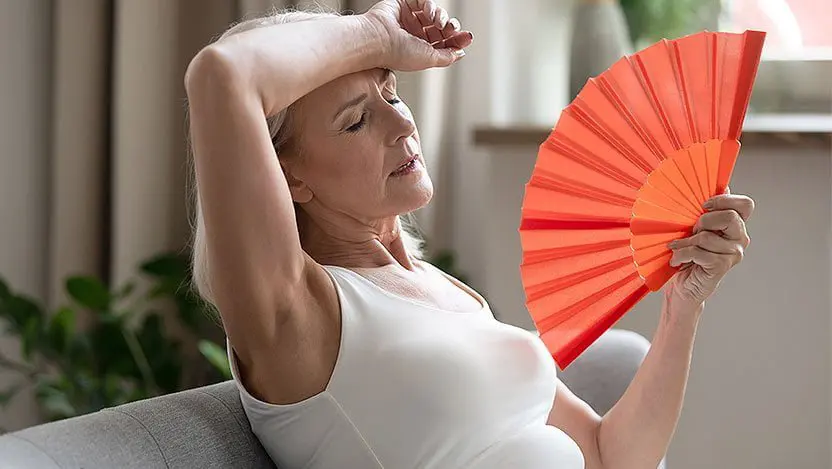As women transition into the postmenopausal phase of life, they often encounter a range of physical and emotional changes. One of the most common and disruptive symptoms is hot flashes. Fortunately, there are various approaches and treatments available to help manage postmenopausal hot flashes effectively. In this blog, we will explore the causes of hot flashes, and provide hot flashes postmenopausal treatment and lifestyle adjustments that can bring relief and empower women to reclaim control over their well-being.
Contents
What Are The Causes Of Hot Flashes Postmenopausal?
 Postmenopausal hot flashes are primarily attributed to hormonal changes, particularly the decline in estrogen levels. As women enter menopause, typically around the age of 51, their ovaries produce less estrogen, leading to hormonal fluctuations that can trigger hot flashes. Here are some key factors contributing to postmenopausal hot flashes:
Postmenopausal hot flashes are primarily attributed to hormonal changes, particularly the decline in estrogen levels. As women enter menopause, typically around the age of 51, their ovaries produce less estrogen, leading to hormonal fluctuations that can trigger hot flashes. Here are some key factors contributing to postmenopausal hot flashes:
1. Hormonal Changes
The most significant factor is the decrease in estrogen levels during and after menopause. Fluctuating hormone levels affect the hypothalamus, the part of the brain that regulates body temperature, leading to a more sensitive response to changes.
2. Hypothalamus Dysfunction
The hypothalamus is responsible for maintaining a stable body temperature. Estrogen deficiency can disrupt its function, causing the body to perceive normal changes in temperature as overheating, leading to the onset of hot flashes.
3. Triggers and Aggravating Factors
Spicy foods, caffeine, and alcohol are known to trigger or exacerbate hot flashes in some women. Also, emotional stress and anxiety can contribute to the frequency and intensity of hot flashes.
4. Lifestyle Factors
Women who smoke may experience more severe and frequent hot flashes compared to non-smokers. Also, lack of regular exercise can contribute to overall health issues and worsen menopausal symptoms.
5. Body Weight
Studies suggest that women with a higher body mass index (BMI) may experience more intense and frequent hot flashes.
Understanding the multifactorial nature of postmenopausal hot flashes is essential for tailoring effective management strategies. Women should consult with their healthcare providers to discuss personalized approaches based on their health history and individual needs.
What Are Some Hot Flashes Postmenopausal Treatment Options?
Several treatment options are available to manage hot flashes in postmenopausal women. Women need to discuss these options with their healthcare providers to determine the most appropriate and effective approach. Here are some common hot flashes postmenopausal treatment options:
Hormone Replacement Therapy (HRT)
Hormone replacement therapy involves supplementing the declining levels of estrogen during menopause to alleviate symptoms like hot flashes. Estrogen therapy is particularly effective in reducing the frequency and severity of hot flashes. However, its use comes with potential risks, such as an increased risk of blood clots, strokes, and certain cancers.
As a result, the decision to undergo HRT should be made on an individual basis, considering a woman’s overall health, medical history, and the severity of her menopausal symptoms. Healthcare providers carefully weigh the benefits and risks, and if HRT is deemed suitable, they often prescribe the lowest effective dose for the shortest duration.
Non-Hormonal Medications
Non-hormonal medications, such as selective serotonin reuptake inhibitors (SSRIs) and serotonin-norepinephrine reuptake inhibitors (SNRIs), have shown efficacy in reducing hot flashes. Antidepressants like venlafaxine and paroxetine can be prescribed to manage menopausal symptoms.
These medications work by affecting neurotransmitters in the brain, helping to regulate the body’s response to temperature changes. While they are generally well-tolerated, side effects should be discussed with a healthcare provider. Gabapentin and pregabalin, originally used for seizures and nerve pain, are also alternative options that may provide relief from hot flashes.
Herbal and Dietary Supplements
 Some women turn to herbal remedies and dietary supplements to manage hot flashes. Black cohosh, derived from a plant native to North America, is a popular choice and has demonstrated efficacy in reducing menopausal symptoms. Additionally, soy-based foods and supplements rich in isoflavones, which have estrogen-like effects, are thought to alleviate hot flashes. It’s important to note that while many women find relief from these supplements, scientific evidence supporting their effectiveness is not conclusive, and individual responses can vary.
Some women turn to herbal remedies and dietary supplements to manage hot flashes. Black cohosh, derived from a plant native to North America, is a popular choice and has demonstrated efficacy in reducing menopausal symptoms. Additionally, soy-based foods and supplements rich in isoflavones, which have estrogen-like effects, are thought to alleviate hot flashes. It’s important to note that while many women find relief from these supplements, scientific evidence supporting their effectiveness is not conclusive, and individual responses can vary.
Lifestyle Modifications
Lifestyle modifications play a significant role in managing postmenopausal symptoms, including hot flashes. Regular exercise has been shown to reduce the frequency and intensity of hot flashes. Engaging in at least 150 minutes of moderate-intensity exercise per week can have positive effects on overall health and well-being.
Dietary changes, such as avoiding triggers like spicy foods, caffeine, and alcohol, can also help in managing symptoms. Women are encouraged to adopt a healthy lifestyle, incorporating a well-balanced diet and stress-reduction techniques to enhance the effectiveness of these non-pharmacological approaches to hot flash management.
Behavioral Therapies
Behavioral therapies, particularly cognitive-behavioral therapy (CBT), focus on addressing the psychological aspects of menopausal symptoms, including stress and anxiety. CBT involves identifying and changing negative thought patterns and behaviors and promoting coping strategies and stress management techniques. While CBT may not directly reduce the physiological occurrence of hot flashes, it can enhance a woman’s ability to cope with the emotional aspects of these symptoms. Integrating behavioral therapies into a comprehensive treatment plan may contribute to an improved overall quality of life during the postmenopausal stage.
Acupuncture
Acupuncture, an ancient Chinese practice involving the insertion of thin needles into specific points on the body, has gained attention as a potential treatment for hot flashes. While research on the effectiveness of acupuncture in managing menopausal symptoms is mixed, some studies suggest that it may offer relief. The mechanism of action is not fully understood, but it is believed to influence the central nervous system, potentially impacting hormonal regulation. Women considering acupuncture should consult with a qualified practitioner, and while generally safe, potential risks and benefits should be discussed with a healthcare provider.
Cooling Techniques
Practical approaches involving cooling techniques can provide immediate relief from the discomfort associated with hot flashes. Using cooling bedding and clothing made from breathable fabrics, such as cotton, can help regulate body temperature and minimize night sweats. Keeping the bedroom cool and using a fan can create a more comfortable sleep environment.
These strategies, although not addressing the root cause of hormonal fluctuations, can enhance the overall comfort and well-being of women experiencing postmenopausal hot flashes. Women are encouraged to explore and combine various cooling techniques to find what works best for them.
It’s crucial to note that individual responses to treatments can vary, and what works for one person may not work for another. Additionally, the risks and benefits of each option should be carefully considered in consultation with a healthcare provider. Regular follow-ups with the healthcare team are important. They will help to monitor the effectiveness of the chosen treatment and make any necessary adjustments.
Do Postmenopausal Hot Flashes Go Away?
 Postmenopausal hot flashes can vary widely in duration and intensity among women. For some women, hot flashes may persist for a few years after menopause, while for others, they may continue for a more extended period. In certain cases, postmenopausal hot flashes can last for a decade or more. However, it’s important to note that for the majority of women, the frequency and intensity of hot flashes tend to decrease over time.
Postmenopausal hot flashes can vary widely in duration and intensity among women. For some women, hot flashes may persist for a few years after menopause, while for others, they may continue for a more extended period. In certain cases, postmenopausal hot flashes can last for a decade or more. However, it’s important to note that for the majority of women, the frequency and intensity of hot flashes tend to decrease over time.
The natural course of postmenopausal hot flashes is influenced by several factors, including individual genetics, lifestyle, and overall health. Some women may experience a rapid decline in the frequency and severity of hot flashes, while others may notice a more gradual reduction.
While postmenopausal hot flashes often improve with time, individual experiences can vary. Some women may find that their symptoms resolve completely, while others may continue to have occasional hot flashes. If postmenopausal symptoms are particularly bothersome or impacting a woman’s quality of life, it’s advisable to discuss available treatment options with a healthcare provider. Regular check-ups with a healthcare professional can help monitor progress and make adjustments to the treatment plan as needed.
Conclusion
In conclusion, hot flashes postmenopausal treatment involves a personalized approach that considers individual factors and preferences. From understanding the hormonal changes triggering hot flashes to exploring treatment options like hormone replacement therapy, non-hormonal medications, and lifestyle adjustments, women have a range of strategies to find relief. Lifestyle modifications, such as regular exercise and a balanced diet, play a key role, while alternative therapies offer additional options.
While the duration of postmenopausal hot flashes varies, the majority of women experience a gradual reduction in frequency and intensity over time. By staying informed and adopting a holistic approach, women can navigate this phase of life with greater comfort and well-being. If you are facing menopause-related issues, menopause treatment at HerMantra can help. Book your free trial online menopause treatment session now.


